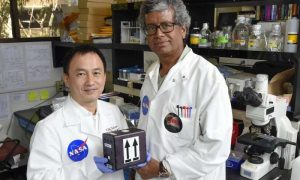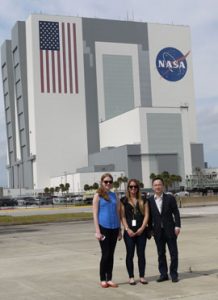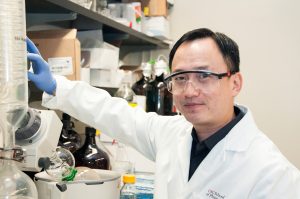Overexpression of an LaeA-like Methyltransferase Upregulates Secondary Metabolite Production in Aspergillus nidulans.
ACS Chem Biol.
CC Wang et al.
2019
Fungal secondary metabolites (SMs) include medically valuable compounds as well as compounds that are toxic, carcinogenic, and/or contributors to fungal pathogenesis. It is consequently important to understand the regulation of fungal secondary metabolism. McrA is a recently discovered transcription factor that negatively regulates fungal secondary metabolism. Deletion of mcrA ( mcrAΔ), the gene encoding McrA, results in upregulation of many SMs and alters the expression of more than 1000 genes. One gene strongly upregulated by the deletion of mcrA is llmG, a putative methyl transferase related to LaeA, a major regulator of secondary metabolism. We artificially upregulated llmG by replacing its promoter with strong constitutive promoters in strains carrying either wild-type mcrA or mcrAΔ. Upregulation of llmG on various media resulted in increased production of the important toxin sterigmatocystin and compounds from at least six major SM pathways. llmG is, thus, a master SM regulator. mcrAΔ generally resulted in greater upregulation of SMs than upregulation of llmG, indicating that the full effects of mcrA on secondary metabolism involve genes in addition to llmG. However, the combination of mcrAΔ and upregulation of llmG generally resulted in greater compound production than mcrAΔ alone (in one case more than 460 times greater than the control). This result indicates that deletion of mcrA and/or upregulation of llmG can likely be combined with other strategies for eliciting SM production to greater levels than can be obtained with any single strategy.
Read More
Proteomic and Metabolomic Characteristics of Extremophilic Fungi Under Simulated Mars Conditions.
Frontiers in Microbiology
CC. Wang
2019
Filamentous fungi have been associated with extreme habitats, including nuclear power plant accident sites and the International Space Station (ISS). Due to their immense adaptation and phenotypic plasticity capacities, fungi may thrive in what seems like uninhabitable niches. This study is the first report of fungal survival after exposure of monolayers of conidia to simulated Mars conditions (SMC). Conidia of several Chernobyl nuclear accident-associated and ISS-isolated strains were tested for UV-C and SMC sensitivity, which resulted in strain-dependent survival. Strains surviving exposure to SMC for 30 min, ISSFT-021-30 and IMV 00236-30, were further characterized for proteomic, and metabolomic changes. Differential expression of proteins involved in ribosome biogenesis, translation, and carbohydrate metabolic processes was observed. No significant metabolome alterations were revealed. Lastly, ISSFT-021-30 conidia re-exposed to UV-C exhibited enhanced UV-C resistance when compared to the conidia of unexposed ISSFT-021.
Read More
International Space Station conditions alter genomics, proteomics, and metabolomics in Aspergillus nidulans.
Applied Microbiology and Biotechnology
CC. Wang et al.
2019
The first global genomic, proteomic, and secondary metabolomic characterization of the filamentous fungus Aspergillus nidulans following growth onboard the International Space Station (ISS) is reported. The investigation included the A. nidulans wild-type and three mutant strains, two of which were genetically engineered to enhance secondary metabolite production. Whole genome sequencing revealed that ISS conditions altered the A. nidulans genome in specific regions. In strain CW12001, which features overexpression of the secondary metabolite global regulator laeA, ISS conditions induced the loss of the laeA stop codon. Differential expression of proteins involved in stress response, carbohydrate metabolic processes, and secondary metabolite biosynthesis was also observed. ISS conditions significantly decreased prenyl xanthone production in the wild-type strain and increased asperthecin production in LO1362 and CW12001, which are deficient in a major DNA repair mechanism. These data provide valuable insights into the adaptation mechanism of A. nidulans to spacecraft environments.
Read More
Genomic Characterization and Virulence Potential of Two Fusarium oxysporum Isolates Cultured from the International Space Station.
M. Systems
CC. Wang et al.
2019
Two isolates of Fusarium oxysporum, ISS-F3 and ISS-F4, were cultured from the dining table on the International Space Station (ISS). Genomic analyses using EF-1α sequences, presence/absence of effector proteins, k-mer comparisons, and single nucleotide polymorphisms indicate that these two strains are genomically different from 65 known sequenced strains. Functional analysis revealed that ISS-F3/F4 had higher relative abundances of polyketide synthase domains than a non-plant-pathogenic soil isolate, used for biocontrol properties (Fo47), and a clinical isolate (FOSC-3a). Putative secondary metabolite analysis indicates that ISS-F3/F4 may produce yet-unreported polyketides and nonribosomal peptides. While genomic analysis showed that these ISS strains are unlikely to be plant pathogens, a virulence assay using an immunocompromised Caenorhabditis elegans model of fusariosis revealed that they were virulent and may represent opportunistic pathogens in animals, including humans. However, its effects on the health of immunocompromised humans warrant further study. IMPORTANCE This is the first study to isolate and characterize F. oxysporum isolates from a built environment, as well as one that has been exposed to space. The characterization and analysis of these two genomes may have important implications for the medical, agricultural, and food industries as well as for the health of the crew who coinhabit the ISS with these strains.
Read More
Proteomic characterization of Aspergillus fumigatus isolated from air and surfaces of the International Space Station.
Fungal Genet Biol.
CC. Wang et al.
2019
The on-going Microbial Observatory Experiments on the International Space Station (ISS) revealed the presence of various microorganisms that may be affected by the distinct environment of the ISS. The low-nutrient environment combined with enhanced irradiation and microgravity may trigger changes in the molecular suite of microorganisms leading to increased virulence and resistance of microbes. Proteomic characterization of two Aspergillus fumigatus strains, ISSFT-021 and IF1SW-F4, isolated from HEPA filter debris and cupola surface of the ISS, respectively, is presented, along with a comparison to well-studied clinical isolates Af293 and CEA10. In-depth analysis highlights variations in the proteome of both ISS-isolated strains when compared to the clinical strains. Proteins that showed increased abundance in ISS isolates were overall involved in stress responses, and carbohydrate and secondary metabolism. Among the most abundant proteins were Pst2 and ArtA involved in oxidative stress response, PdcA and AcuE responsible for ethanol fermentation and glyoxylate cycle, respectively, TpcA, TpcF, and TpcK that are part of trypacidin biosynthetic pathway, and a toxin Asp-hemolysin. This report provides insight into possible molecular adaptation of filamentous fungi to the unique ISS environment.
Read More





